DIY Coming Attractions
August 18, 2010
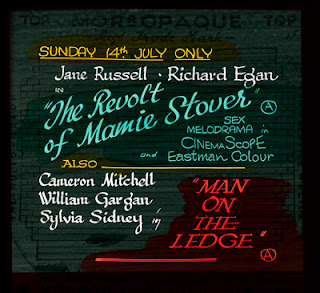
Professionally produced slides were not the only projected images that theaters used to advertise their upcoming shows. The exhibitors themselves often crafted hand-made slides. These slides generally consisted exclusively of written text and lacked any but the most primitive graphic elements. Though the slides often lacked aesthetic interest, they had the practical benefit of flexibility as well as the ability to very specifically address the details of an upcoming program.
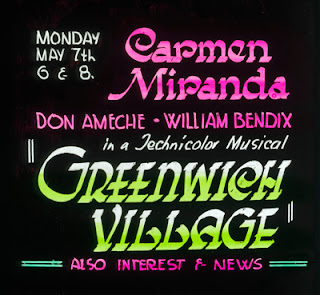
For example, handmade slides were useful for advertising an entire program, such as a double feature, on a single slide. Custom made slides also allowed for of insertion of specific dates or times, commentary or tag lines ("Back by popular demand!), or local censorship ratings.
Custom slides could also be quickly fabricated in order to flash an immediate message to the screen.
Film historian Kevin Brownlow recently related a personal anecdote in an email which illustrates the point. I'm sure he wouldn't mind if I shared it here:
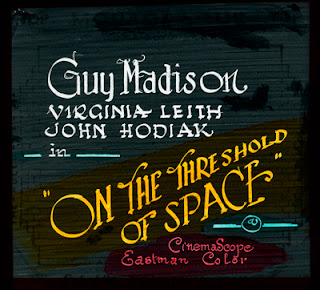
"When I was a few months old, my parents went to the local cinema in Crowborough, Sussex, leaving my aunt looking after me. I must have sensed what was going on, because I roared so furiously that my aunt had to telephone the cinema and they projected a slide (over the film - sacrilege!) with handwritten lettering saying 'Would Mrs Brownlow please return to Kevin.' So I had my name on the screen at six months."
Projectionists had several different processes by for laying their message on glass, all of which essentially boil to two different approaches.
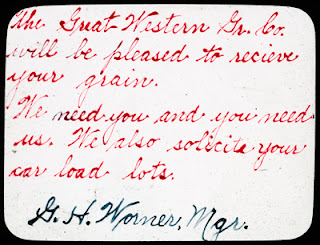
The first approach is to simply take an appropriately sized pane of glass and write on it using ink, paint, or grease pencil. When projected, the resulting image is a white background with black or colored text. This technique is described in the 1915 manual, A Guide to Kinematography (Projection Section) for Managers, Manager Operators, and Operators of Kinema Theatres by Colin N. Bennett.
Bennet describes how to create these "Painted-on Announcement Slides":
"Simply paint or write on the clear glass. For painting, any opaque mixture will serve. Light red or ultramarine blue water colour paints are good, and the glass can easily be cleaned off again. To write in words with a pen, use a ball-pointed or broad-pointed nib and a mixture of ordinary writing ink and ultramarine blue of the consistency of very thin paste. Electric lamp lacquer (white spirit varnish coloured with alcohol soluble aniline dye) may be flowed over the uncoated side of the announcement slides to introduce colour and make them less glaring on the screen."
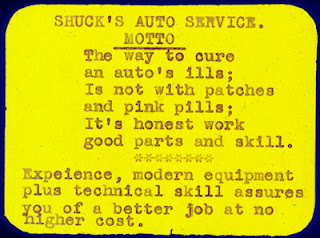
An alternate method for creating a custom slide was to coat the entire surface of the glass with an opaque material, and then to etch the message through the coating.
This process had the advantage that the projected image appeared on the screen as light against a dark background instead of the other way around. Another advantage was that the scratched out areas could be covered by a color wash, thus affording the opportunity for multicolor text and embellishment.
Returning to Bennett's manual, he describes the Preparation of Scratched-in Announcement Slides":
"Cover a clean 3 ¼ inch square of glass [note the standard British slide dimension] with any opaque coating that can be scratched off in fine lines with a sharp pointed instrument, such as a sharpened knitting needle, or a darning needle stuck for support in a cork, leaving the point jutting out half an inch. White, or light green, Hall's water distemper is a simple announcement slide coating..." Bennett then continues to recite half a dozen alternatives for uniformly coating the glass, and then concludes "...the finest possible lines can then be cleanly made. The wording of all scratched-in announcement slides projects white on a dark background."
This "Scratched-In" process apparently later became quite popular, so much so that a British company, Morgans's Slides Limited, developed pre-coated blank slides and sold them under the trade name MORROPAQUE. The coating on these slides was pre-ruled with very fine lines to assist the exhibitor in aligning their written text. The coating also easily accepted color dye, so that that exhibitors could creatively color them as well.
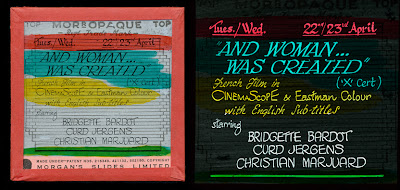
Though these hand made slides lack the drama and striking visual appeal of professionally produced studio slides, they have a certain charm that I've come to appreciate. Not only do they provide insight into typical programming practices, they also wonderfully demonstrate the lost art of good penmanship.
